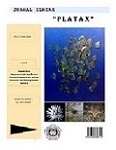Biometric Analysis of Otolith (Sagitta) for the Stock Separation of Skipjack Tuna Katsuwonus pelamis (Linnaeus, 1758) Landed at Tumumpa Coastal Fisheries Port Manado, North Sulawesi
DOI:
https://doi.org/10.35800/jip.7.2.2019.24124Abstract
Skipjack tuna, Katsuwonus pelamis (Linnaeus, 1758) is one of the most important species for Indonesian marine capture fisheries and is the third major species of capture fisheries in the world. This study aims to analyze the biometry of otolith (sagitta) of skipjack tuna caught with ‘soma pajeko’ (mini purse-seine) around FADs in the Sulawesi Sea. A total of 96 individuals of skipjack tuna measuring total length (TL) ranged between 232 and 625 mm and the average of TL was 419.64 mm (SD = 112.78 mm) were successfully taken otolith without defects. The length of otolith (OL) of the skipjack tuna ranged between 2.693 and 5.269 mm with an average of OL was 3.435 mm (SD = 0.602 mm). For both the size and shape indices of the otolith, there were no significant difference between the left and right otoliths for otolith length (OL), otolith perimeter (OP), Form-Factor (FF) and Roundness (Rnd), but asymmetric influences were very significance for otolith width (OW), otolith area (OA), Circularity (Cir), Rectangularity (Rec), Ellipticity (Ell) and Aspect Ratio (AR). There were no significant difference in the mean size and shape indices of the otolith between females and males. The relationship between TL - OL follows the power function: OL = 1.027993 * TL0.198863 (R2 = 13.18%). The low value of R2 seems to be due to the mixing of more than one stock of skipjack tuna in the sample. Separation of observation data in the relationship between TL - OL into two different stocks can increase the value of b or R2. It is possible for skipjack tuna in the Sulawesi Sea to consist of two different stocks. The separation of the two stocks can mainly be determined by the size of the otolith, the size of the otolith of stock 1 is relatively large compared to stock 2. The relationship of ln (TL) - ln (OL) stock 1 and stock 2 were ln (OL) = -2,282 + 0,610 * ln (TL) (n = 53; r = 0.91) and ln (OL) = -2,363 + 0.566 * ln (TL) (n = 43; r = 0.64). It is possible that stock 1 is the stock of the Indian Ocean and stock 2 is the stock of the Western Pacific Ocean. To test this hypothesis, genetic studies are needed.
Keywords: otolith biometry, stock separation, Katsuwonus pelamis, Sulawesi Sea
ABSTRAK
Ikan cakalang, Katsuwonus pelamis (Linnaeus, 1758) merupakan salah satu spesies yang sangat penting untuk perikanan tangkap laut Indonesia dan merupakan spesies utama urutan ke-3 perikanan tangkap dunia. Penelitian ini bertujuan untuk menganalisis biometri otolit (sagitta) ikan cakalang yang tertangkap dengan ‘soma pajeko’ (mini purse-seine) di sekitar rumpon di Laut Sulawesi. Sejumlah 96 individu ikan cakalang berukuran panjang total (TL) 232 - 625 mm dan rata-rata TL 419,64 mm (SD = 112,78 mm) berhasil diambil otolitnya tanpa cacat. Otolit (kiri) ikan cakalang tersebut berukuran panjang (OL) 2,693 - 5,269 mm dengan rata-rata OL 3,435 mm (SD = 0,602 mm). Baik untuk ukuran maupun indeks bentuk otolit, tidak terdapat perbedaan yang nyata antara otolit kiri dan kanan untuk panjang otolit (OL), keliling otolit (OP), Form-Factor (FF) dan Roundness (Rnd), tetapi pengaruh asimetris untuk lebar otolit (OW), luas otolit (OA), Circularity (Cir), Rectangularity (Rec), Ellipticity (Ell) dan Aspect Ratio (AR) sangat nyata. Tidak terdapat perbedaan yang nyata rata-rata ukuran maupun indeks bentuk otolit antara betina dan jantan. Hubungan TL - OL mengikuti fungsi perpangkatan: OL = 1,027993*TL0,198863 (R2 = 13,18%). Rendahnya nilai R2 ini nampaknya disebabkan karena bercampurnya lebih dari satu stok ikan cakalang dalam sampel. Pemisahan data amatan dalam hubungan TL – OL menjadi dua stok yang berbeda dapat menaikkan nilai b maupun R2. Ikan cakalang yang terdapat di Laut Sulawesi ada kemungkinan terdiri dari dua stok yang berbeda. Pemisahan kedua stok tersebut terutama dapat ditentukan lewat ukuran otolitnya, stok 1 berukuran otolit relatif besar dibandingkan dengan stok 2. Hubungan ln(TL) – ln(OL) stok 1 dan stok 2 berturut-turut adalah ln(OL) = -2,282 + 0,610*ln(TL) (n = 53; r = 0,91) dan ln(OL) = -2,363 + 0,566*ln(TL) (n = 43; r = 0,64). Ada kemungkinan stok 1 merupakan stok Samudra Hindia dan stok 2 merupakan stok Samudra Pasifik Barat. Untuk menguji hipotesis ini diperlukan kajian secara genetik.
Kata kunci: biometri otolit, pemisahan stok, Katsuwonus pelamis, Laut Sulawesi
Downloads
Published
How to Cite
Issue
Section
License
COPYRIGHT
Authors who publish with this journal agree to the following terms:
Authors hold their copyright and grant this journal the privilege of first publication, with the work simultaneously licensed under a Creative Commons Attribution License that permits others to impart the work with an acknowledgment of the work's origin and initial publication by this journal.
Authors can enter into separate or additional contractual arrangements for the non-exclusive distribution of the journal's published version of the work (for example, post it to an institutional repository or publish it in a book), with an acknowledgment of its underlying publication in this journal.
Authors are permitted and encouraged to post their work online (for example, in institutional repositories or on their website) as it can lead to productive exchanges, as well as earlier and greater citation of the published work (See The Effect of Open Access).






































